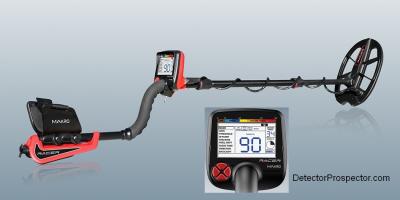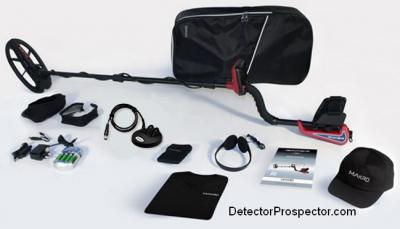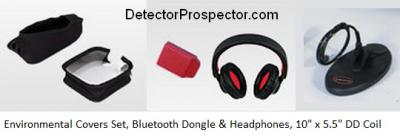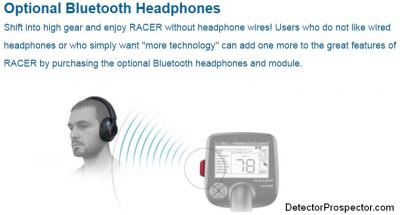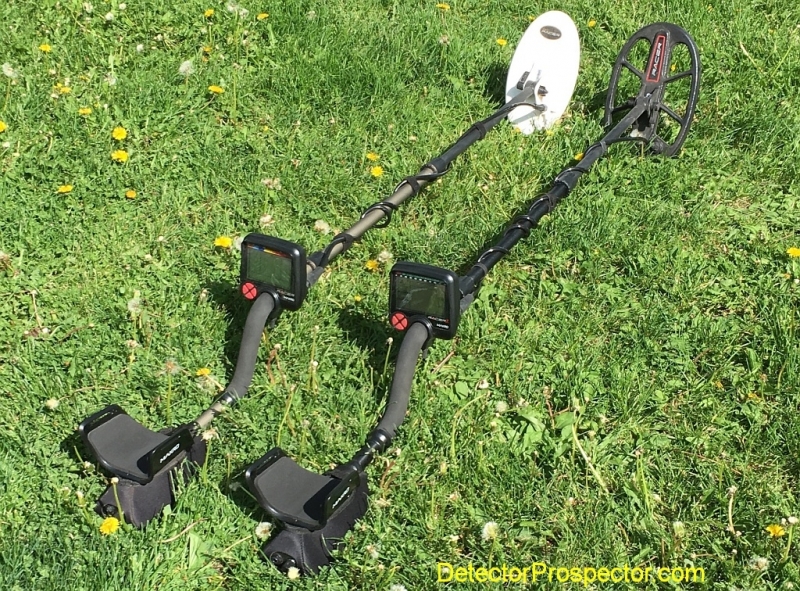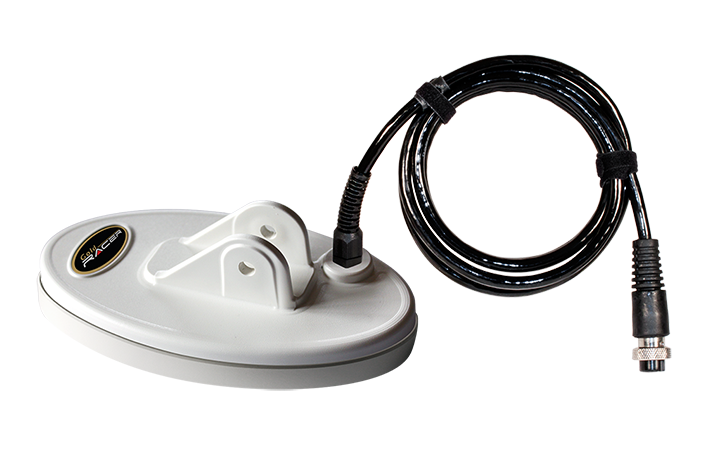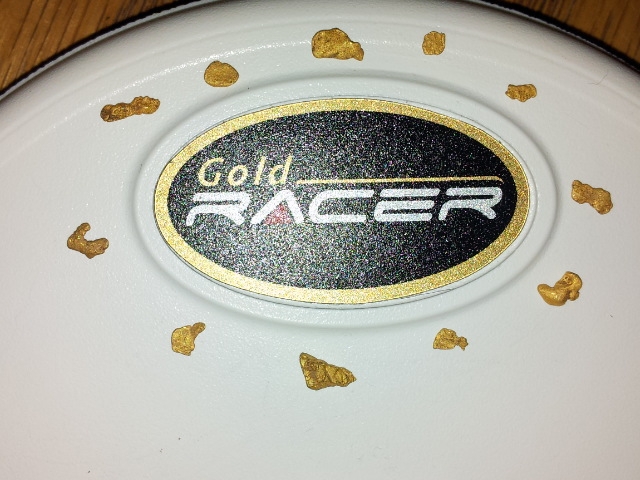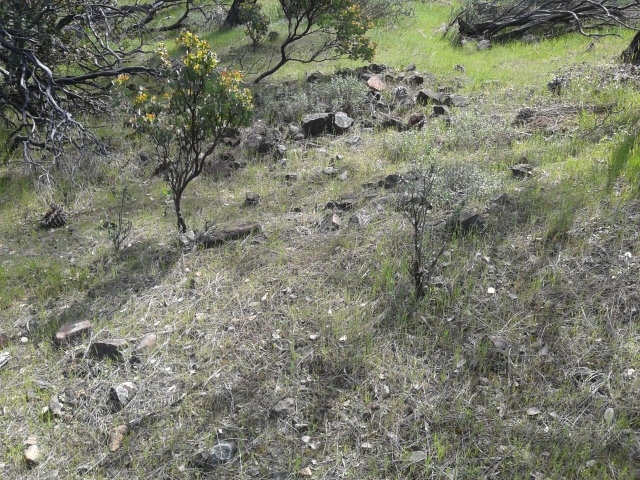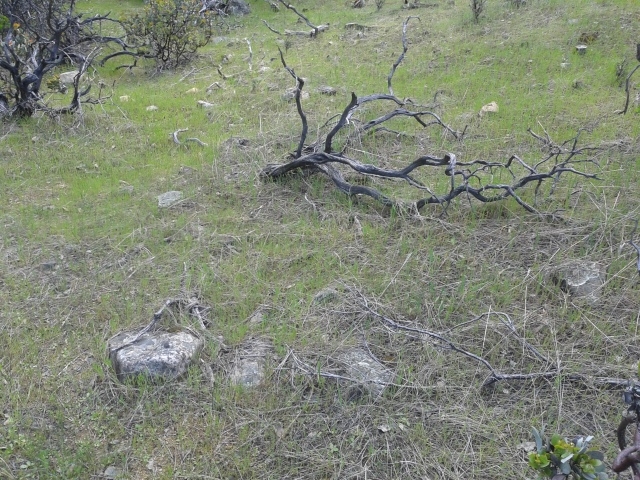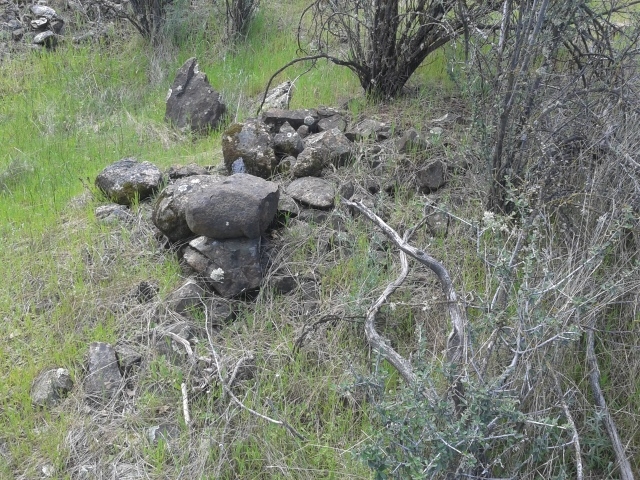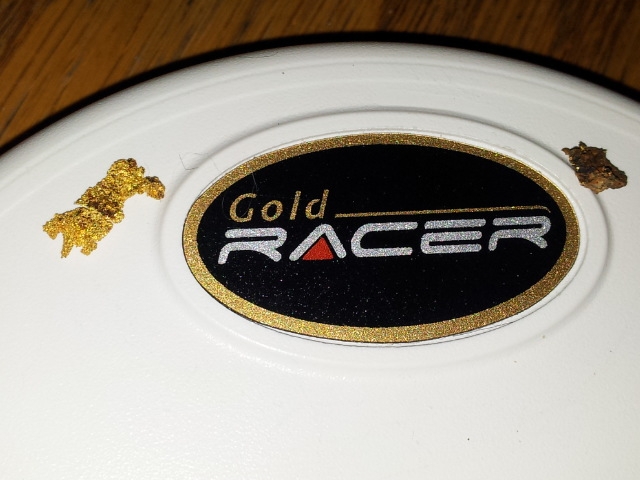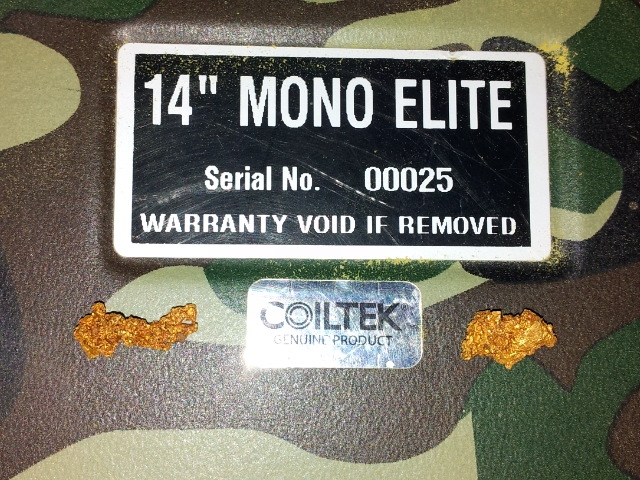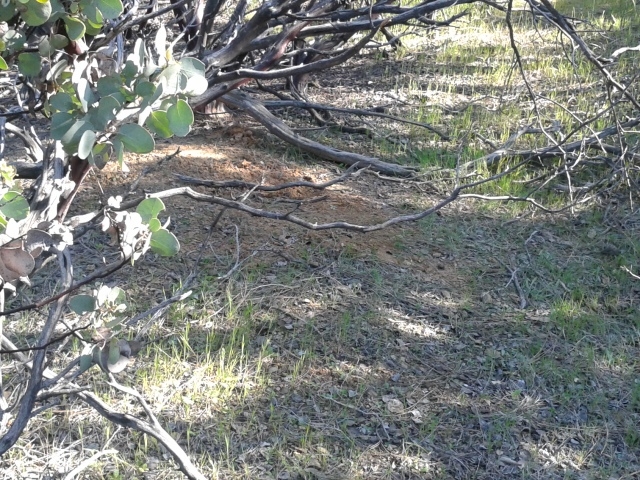Search the Community
Showing results for tags 'makro racer'.
-
It has been said that the Gold Racer is probably not your best choice for hunting sites with lots of iron trash, Probably true, especially when hunting cellar holes and such, but detectors that do better give up sensitivity to small gold like micro jewelry which is what I like to hunt these days. I have begun a concentrated learning process on the idea of target masking and applying it to the use of the Makro Gold Racer. The idea is to read what can be found, then apply, then read some more, rinse and repeat. So far, these techniques have proven useful. Gleaned from posts here and other places, they are fundamental ideas that come up a lot wherever the topic is discussed. Use a smaller coil. For this the 4X7 elliptical was purchased Increase recovery speed. Using iSAT of 9 seems to work best here Decrease Gain. I have been doing this with good result, but still keep it pushed as high as the specific site will allow. More iron=less Gain thinking. Slow sweep speed. Though the owner's manual recommends a faster sweep, slightly above a crawl is working well. Hunt in All Metal Mode Dig iffy signals The idea of working on this particular idea was originally started simply as a way to work some really trashy sites visited recently, but the idea has much greater application, as was found today. The study of target masking shows why loud and clear. The presence of junk influences the sound and TID of good targets if they can be heard at all. All Metal Mode sees everything and lets you sort out the iffy yourself, which can be very tedious and slow, but it will work. More good targets can be recovered even from relatively clean sites. Plus you will get a lot of exercise. So this is the idea in mind, and the current set of techniques to make use of it, and this morning was applied to a volleyball court hunted before with stock coil and normal sweep speed. Three stud earrings were recovered, all iffy signals. One garnet, two cubic zirconias. I do not think any of them were even real gold, which may contribute to the iffiness, but these were targets of the size and shape I want and would not have been dug before. It appears useful to not be overly reliant on the screen id, and pay more attention to the tone. Having issues with this small coil now again too, a large number of false overload signals were found today. Removing the coil cover and replacing it did not help this time, lowering the gain did, though I pushed it back up whenever I got the chance. No metal at all could be found in these various hot spots. The ground is saturated from recent rains, but the phenomena did not seem to correlate with low spots and the ground has had a couple days to dry out.. This replacement coil does seem to relieve the constant overload problem I had with the first one, and usually does not do this, but I am kind of wishing I had gotten the small round dd. Who knows. Any who have suggestions and ideas concerning target masking as a concept or technique to get around it, please chime in. Learning to unmask with a Gold Racer could be a great tool. What I know so far for what is worth.
-
I bought a gold racer with both std coil and smaller 7"DD. Did some air testing and well this is opposed to conventional wisdom, but it easily sees fine gold in a bottle with water. In fact do not have a bottle of fines it can not see! Settings very much affect the depth. In all metal the finest gold in a bottle is seen at 2.5" IDs at 1.5" and IDs at 16-18. In Discrim it varies but generally less. Discrim #2 is better of both. Medium fines 3.5" at some Discrim settings and IDs at 38. It works about the same with Std and small coil. Have not tried in field yet, that is tomorrow. There is one good thing about this, people lose gold bottles, if its 3" or less would expect to be able to find one. So this was pleasant surprise. On downside the better pieces in air tests are not as deep as would expect, The small coil with "all metal" sees medium fines bottle at 4" yet can only see a pickup with thickness that is 3/16"x1/8" at 3.5" even though it is much bigger than anything in bottle. And a small piece at 1/16"x 1/12" can be seen at 2.5", so only increases depth 1" for a piece that weighs likley 6-7 times more. BTW the bottles do not have a lot of gold, bigger fines maybe 1 pennyweight, finest fines about 1/2 pennyweight. Thought this info on bottle fines may be of interest, next step see how gold racer works in the field. Love the adjustability of this detector. Cheers
-
Have been lurking here for about a year. Just signed up. Heard of gold racer from Rick Solinski who is the cameraman above with Scott Chiara finding a tiny piece of gold. Steve, thanks for you superb reviews! We met at the Reno GPAA show 3 years ago when we announced the SierraBlaster, you enjoyed the video of the 13 foot boulder blast. The above video convinces me that gold racer can find the small sizes. The next question does the gold racer have the ability to eliminate most non-gold digs if the user is willing to walkover lets say 1/3 of the gold targets? I prospect in Yuba/Feather area on gravel bars, canyon walls and hydraulic pits. In all metal its going to be maybe 98% non-gold targets. On gravel bars primary purpose would be to find the pay streak and mark it, as 2 flakes and 5-15 colors is fairly typical on the top in a pan, and hope for a quartzie. Have seen a 1.5 oz quartzie with 1/3rd oz gold go right thru a sluice, many are left behind. And want to check sluice tailing every few hours too. 1. If am willing to bypass 1/3 of the gold do you, or anyone else here, think one can dig over 50% gold with the gold racer in a 98% non-gold target area? 2. When you get 50-70 readings what percent end up being gold in your experiences? 3. Crevice verification: Why scrape em or blast them (the plan with SierraBlaster) if there is no gold in them? Are bedrock crevices any different in terms of depth/discrimination than dirt/gravel? Thanks in advance, Dana
-
Having a problem with the 4.5X7 elliptical coil just purchased and wonder if anyone else has experience with it. At sensitivity 90 and above it overloads, 89 or below it appears to operate normally. Other settings appear to not be involved, just sensitivity. Even running at 89, it seems to offer excellent target separation and beautiful sensitivity to small. Just want to be able to push the gain a bit. Is this just a bad coil or am I doing something wrong?
-
I've been playing with the G.R. at home testing it out with different size nuggets in the ground etc. First time out in the field with the Gold Racer yesterday. I was at a hydraulic pit in the area where the Scott River meets the Klamath River in Siskiyou county Ca. To get a stable threshold the settings were: Sensitivity 69, Threshold 35, iSat 3. The mineralization was 1 bar from max. The ground I started in was about 1/4" dirt over shale. The GR would lock hard at 99, the non-ferrous bar all the way to the right. I dug into the shale/Copper stained soil, kept checking the hole with GR then no more target. I checked the dug out material w/no target. Ok so I thought a glitch and kept swinging. Not more than 8 feet away and same target readings, same rusults. This happened three times . It was getting dark so decided to quit for the day. Steve or any other Gold Racer owners have any thoughts ?
-
Hello Steve, the quote below is part of a message that I received on my site. As you know I refer all the high tech stuff to you. While it is interesting to know some of this stuff I still prefer to just use what continually works for me. I thank you for your time. TRINITYAU/RAYMILLS "A question regarding future use of my new Nokta Au, and the INTERACTION between two of its discrimination-mode controls (it's Discrimination Filter and its iMask function).I have been detecting/prospecting since 1968, minored in geology in college, and in the last decade and more, have owned Bug 2's and successive MineLab units up through my GPX 5000. I find I always do better if I understand my unit's processor/filter operations. So bottom line ... do you or anybody I could communicate with have an explanation of how the two discrimination processors (the Disc. Filter and the iMask) interact, i.e. compliment or conflict with each other??The manual generally refers to the Disc. Filter as being appropriate for trash and the iMask for hot ground and hot rocks, but it appears we are clearly talking about two overlapping discrimination functions here. Nokta's recommended "default positions" fall short of explaining the interaction the two controls' in keeping with the excellent manner they covered the "All-Metal" control interactions on pages 15 and 16.Just to be clear, I'm less interested in other's field experience and much more interested in a page 15 and 16 type explanation of how my Au is using/combining/filtering my "Disc. Filter and iMask setting choices."
-
Typical contrived test in that a gold ring is a near perfect target. Still, I am noting that the Gold Racer at 56 kHz is different than most machines and does have some unique ferrous handling capability. The only problem is the machine is very hot, and can produce some really sparky responses on flat steel that will fake you out. The response time as shown however is near instantaneous and quite impressive in some locations.
-
Dear Valued Customers: First of all, we thank you all for the increasing sales of our Racer series detectors. As you all know, Racer 2 is an addition to our current Makro product line up and we have no intentions of discontinuing the original red Racer. As a matter of fact, for those customers who do not need the extra features of the Racer 2, the original Racer still stands as a very good performing hi-end detector. Many of our dealers and customers have been asking Nokta& Makro for a device that would retail around the $500 price range.. Therefore, as of June 1, 2016 we changed the price of the Racer as below to meet this request. We believe that the new price change makes Racer absolutely the most competitive and attractive product in that price range! RACER STANDARD PACK SUGGESTED RETAIL $499 RACER PRO PACK SUGGESTED RETAIL $699 Thank you!
-
Hello all... back in Turkey from our trip in the USA. Do not want to keep you guys waiting more..here you go - the official pricing info on the Makro RACER: STANDARD PACKAGE - $499 Includes: 29cm x 18.5cm (11" x 7") DD Search Coil Search Coil Cover Headphones 4 x AA Alkaline Batteries PRO PACKAGE - $699 Includes: 11" x 7" DD Search Coil 5.5" x 4.7" DD Search Coil Covers For Both Search Coils Headphones AC & Car Charger 4 x AA Rechargeable Batteries Carrying Bag Treasure Pouch Rain Covers Cap with Official Makro Logo T-Shirt with Official Makro Logo Bluetooth headphones as well as all accessories can be purchased separately. Racer Metal Detector Accessories Manufacturer’s Suggested Resale Price RC13 - DD Search Coil - (13cmx12cm - 5''X4.5'') $109.00 RC26 - DD Search Coil - (26cmx14cm - 10''x5.5'') $139.00 RC29 - DD Search Coil - (29cmx18.5cm - 11''x7'') $159.00 RC40 - DD Search Coil - (40cmx33.5cm - 15.5''X13'') $249.00 RC13 - Search Coil Cover $9.00 RC26 - Search Coil Cover $15.00 RC29 - Search Coil Cover $19.00 RC40 - Search Coil Cover $29.00 Carrying Bag $49.00 Rain Covers (Set of 2) $29.00 Treasure Pouch $9.00 Charging Kit (AC & Car Charger 4 x AA Rechargeable Batteries) $49.00 Cap with Official Makro Logo $15.00 T-Shirt with Official Makro Logo $15.00 Koos Headphone - KPH7 $20.00 Philips SHB7000 Bluetooth Headphones and Dongle $179.00 Bluetooth Dongle Only (BT module) $99.00 Middle Rod $32.00 Lower Rod $16.00 Armrest $28.00 Here is a downloadable pdf price list Makro Racer Metal Detector & Accessories Price List 1/23/2015 More information on the Makro Racer and Makro Gold Racer
-
I knew yours had quit soon after you got it. Any details on what happened and has it been handled? The reason I ask is forum member SLGuin has apparently found new life as Slag on Tom's forum. He also reports getting a Gold Racer and having it fail. My Gold Racer is one of the first off the production line and I have had no issues, but overall with all Nokta/Makro models I have had some concerns over quality control. Early issues mostly revolved around plastics issues like coil ears and coil bolts breaking, but they seem to have that sorted out now. With you and Slag reporting Gold Racer failures I got concerned again, but some searching has not revealed this as being widespread. NokMak in general has been superb in fixing issues when they arise but if they really want to make serious inroads as a manufacturer they need to do all they can to put these types of issues in the past. In all fairness we see problems from all the manufacturers. A new (to us) company has more on the line however and can ill afford to get a reputation for building unreliable product. I got onto the site of an old shack recently with the Gold Racer. My gut feeling has been that the Gold Racer would be too hot for getting into thick ferrous, but it did a great job handling some pretty thick stuff and filling my pouch with non-ferrous targets. As usual flat steel is a challenge as it is with all detectors but I seemed to be getting a handle on it between audio and VDI responses. The unit has something special going with the disc VCO based audio and ability to make low conductors literally squeak. Anyway I know how you like hunting in the trash and hope you will be patient with the Gold Racer because I would like to compare notes with you on it if you continue to use it. I think Harry (LipCa) has one also but he is not saying much so maybe it is not working for him? Maybe he will chime in with a report. So far my only problem has been in trying to find the optimal way to deal with really hot ground. The Gold Bug 2 in worst case scenario you just switch to iron disc mode and it will shut most ground and hot rocks up with maybe just chatter at high gain levels. You can do the same with the Gold a Racer but with two disc modes and multiple disc settings it is more challenging, and I have not spent enough time on really bad ground to find what I think are the best solutions there yet. Northern Nevada is pretty tame and running in Disc Mode 1, Gain 79, ID Filter 10, iMask 0, and lowering tone break from 40 to 35 has been a good starting point for me. I set Disc Mode 2 up similarly but gain of 99. This is in general too hot for normal hunting, but once I get a target, I can switch to this to get a more solid response on weak targets. I do prefer the Gold Racer over the Gold Bug 2 when it comes to disc modes. The Gold Bug 2 has a silent search iron disc that silently rejects most ferrous targets. The Gold Racer can be set to do it this way also but you can vary the ferrous rejection (id filter) setting. In either case however I prefer a two tone setup, low tone ferrous, high tone non-ferrous. The problem with complete rejection is you can pass over a target and never know it was there. Borderline targets may give a poor reading that needs a little analysis and with a low tone alert you get a chance to stop and check questionable targets. The ability to set the tone break on the Gold a Racer really takes it to the next level because you can set the desired level of ferrous bias. I find the stock setting of 40 to be a bit too aggressive for my liking so 35 works better for me at lighting up smaller non-ferrous in bad ground with a high tone. The bottom line is due to my single minded use of the GPZ last year my Gold Racer did not see a lot of hours. Park hunting this spring got me going with it however and what I saw around the old shack intrigued me enough to make me intend on putting in lots more hours this year. I still consider myself to be a Gold Racer novice and would like that to change. I got the small elliptical coil now also and need to get it into use as that was my favorite coil on my Gold Bug 2.
-
Makro Gold Racer and Racer 2 metal detectors Just some tidbits as I play around with these two detectors. The Makro Gold Racer unsurprisingly has an edge on low conductive targets, but even the Makro Racer 2 is geared towards low conductive. Both machines in two tone mode have a VCO type audio response. This means you get not just a solid tone, but a tone that increases with the signal intensity. As you get nearer a target the pitch of the tone increases, to the point that when right on top of a target it can practically squeak. Anyone used to running a Gold Bug will know what VCO audio sounds like. In two tone mode a nail, a dime, and a nickel do not respond quite the way you might think. The nail gives a very low tone response with both detectors. The nickel though will actually sound like a higher tone target than the dime even though in two tone both should in theory be the same. This is because both machines hit harder on a nickel than a dime and the VCO response kicks the tone up. On the Racer 2 and Gold Racer the dime sounds more like a mid tone, the nickel more high tone. This is a relative thing; both items at same depth the nickel hits harder. A deep nickel will sound however like a shallow dime. The Gold Racer at 56 kHz really enhances the low conductive signals, and it hits a nickel twice as hard as a dime. The Racer 2 may be more like a nickel hitting 50% harder than a dime. In two tone mode low conductors really jump out with the Gold Racer. The Racer 2 adds a three tone mode that cleans this up for classic coin hunters. It is far less a VCO effect, more solid tone, and high conductive targets at default settings give a much higher tone. So a nail will go very low tone, nickel solid mid tone, and dime solid high tone, again with minimal VCO effect compared to the two tone modes. Anyone hunting high conductive coins will find Racer 2 three tone mode to generally be the way to go. It is its own mode with its own responses and with a small coil can really do well on coins. That said the Racer 2 is not a depth demon on high conductive coins. I would not buy one just to hunt coins per se if max depth was the goal. It is a relative thing however. I played around with my Deus and 11" round DD coil and it also is no depth demon on high conductive. However, you can flip the Deus from 8 kHz to 18 kHz and watch the responses on a nickel and dime flip right along with the frequency. For just outright depth the Racer 2 and Deus are in the same ballpark in bad ground, but you can get a better high conductive response with Deus at 8 khz than Racer 2 at 14 kHz. My CTX 3030 does better than either in general for depth on coins though again the Racer 2 is very strong on nickels. I do not have the 10x5 elliptical for the Racer 2 so have used both 11x7 elliptical and 5" round DD coils on it. The stock 10x5 DD elliptical on the Gold Racer does a better job at target separation but also punches deeper in bad ground on low conductive targets than the larger coil on the Racer 2. Not in terms of absolute depth per se - it is just that the Gold Racer obtains and maintains a solid non-ferrous signal to better depths while in disc mode. The Racer 2 signal shifts more quickly to a ferrous reading at depth. This is probably a reflection as much of the frequency of the Gold Racer as the coil difference but I do prefer the 10x5 coil with the solid bottom and smaller footprint for what I personally use a detector for. I personally prefer the 5" round DD over the 11x7 DD for the Racer 2 unless I need ground coverage so the optional 10x5 DD would be a good compromise. The Gold Racer with 10x5 coil has tremendous target separation characteristics, easily matching or exceeding my Deus with 11" round DD coil. The super high frequency is unimpressive on high conductive coins at depth, but I have been finding surprising numbers of dimes at fairly shallow depths with it. The high frequency and ground handling I think may give it an edge even on high conductive coins in really bad ground as it hates to let any target VDI numbers get pulled down and with the superb separation - well, lets just say the Gold Racer does far better in parks than I was anticipating, but not because it punches real deep (except on low conductors) than perhaps because of its target separation/ground separation characteristics. The 10x5 concentric on the Gold Racer cleans up the complex multi signal that you tend to get with shallow targets and a DD coil, but does not handle the bad ground as well. It does seem to do even better on low conductors relative to high conductors in bad ground. It is as if the ground effect is canceling the high conductors more than the low conductors with the concentric coil. To the point where a nickel will bang out at twice the depth of a dime using the concentric on the Gold Racer. There currently is no concentric for the Racer 2. I prefer the 10x5 DD on the Gold Racer overall, as the mixed signal on shallow targets tells me they are shallow. But I like the concentric also - I just have not used both in enough different scenarios to have a hard grip on which is best for which situations. I do have two Gold Racers so will have to rig one up with the DD and one the concentric and run together to get a better feel on this. The Racer 2 oddly enough overloads more easily than the Gold Racer on shallow targets. Again I can use the overload as a shallow target indicator so it is not a bad thing, just a difference. Might bug some people though. My gut tells me the Racer 2 will overload on really, really bad ground that the Gold Racer will handle with no problem, but again coils play into that. The Gold Racer splits ferrous from non-ferrous at 40 and the Racer 2 makes the break at 10 (out of 0 - 99 on both machines). This is fine for most items. However, for non-ferrous in bad ground the Gold Racer has the distinct edge. Normal small ferrous on the Gold Racer bangs hard at about 21. The same item on the Racer 2 will hit at about 4. In bad ground, a small item like the smallest lead split shot fishing sinker you can get, will drift as low as about 4 with the Racer 2. The Gold Racer will see a similar item drifting no lower than about 35. That means on the Racer 2 ferrous and non-ferrous can bump right up against each other at about 4. I have been running my Racer 2 with ID filter and tone break set to 4 or maybe even 3 but have not settled on which might be best yet - probably just depends on the situation. The Gold Racer on the other hand you have a 14 point spread between where ferrous normally hits at 21 and a normal low end non-ferrous response at about 35. This is huge and means you have a far better ability to get clean separation between small non-ferrous and ferrous in bad ground. I like hunting jewelry and so depth is not a big issue. I like to hunt more for targets that have both extremely tight VDI clusters and strong responses that indicate they are not super deep. The 56 kHz and VCO response in two tone mode is really working for me. I basically hunt for "squeakers" and the Gold Racer really makes low conductive targets squeak. It is like hunting with a Deus in Pitch Mode. The Racer 2 works for this also but not as well due to the lower operating frequency. I really am just blabbing observations here in hopes there might be useful tidbits for somebody. I right now have four machines that overlap to some degree - Gold Racer, Racer 2, Deus, and CTX. More and more I am finding what works for me is a collection of specialty machines with specific uses. Minelab GPZ - nearly all nugget detecting Garrett ATX - water detecting DFX/Bigfoot - jewelry Minelab CTX - coin detecting The Gold Racer at 56 kHz is different enough to fit the bill for me as a specialty unit. Great for gold the GPZ can't see, or nuggets in trashy areas. But I am finding it to be a great park and tot lot hunter, not just for jewelry but for quite a pile of coins that have been popping up while jewelry detecting. Kind of like hunt jewelry and find lots of coins by accident. So it joins the group above. The Deus just has its own kind of magic and lots to learn there for me, so it stays put for awhile, possibly as part of the permanent collection. The Racer 2 though I am struggling with in a way. It is a great all around detector, and if it was all I had I would be quite happy. I prefer it to many of the other 13 - 15 khz machines on the market. But when I put it up against my core units - well, I like the Gold Racer more for gold/jewelry detecting. And I like the CTX more for chasing silver coins. The Racer 2 actually does give the Deus a run due to the small coil but the Deus has the four frequencies to work with and weighs a pound less. Costs twice as much also! So I run into a situation where the Racer 2 like the Fisher F75 or Garrett AT Pro or Minelab 705 or Teknetics T2 or White's MXT is a superb do-it-all machine. But for any one given task, one of my specialty units will eclipse every one of those detectors. So while I am in no hurry to part ways with the Racer 2 I am not really counting it as a core necessity unit either. It may do nearly everything well but I have not found that one magic thing it does better than anything else - and that is what it takes for a detector to find a permanent place in my collection. The Gold Racer though is getting double duty. If I go gold prospecting my GPZ is main unit, Gold Racer secondary though for specific situations the Gold Racer is lead unit. Same situation now exists with my DFX/Bigfoot and Gold Racer but a bit more a pair of equals there. The DFX/Bigfoot is for any large area. But for anywhere I really want to clean it up the Gold Racer does the trick so for tot lots and similar situations the Gold Racer is the better jewelry machine and a clad coin vacuum. P.S. The main thing I really like on the Racer 2 is the ability to set three custom tone ranges each with their own tone, and also an iron volume setting. If I had to choose a machine just for jewelry detecting it would be the alternative to the DFX because of this. If there was a Bigfoot type coil for the Racer 2 then it is almost certain I would sell the DFX and replace it with the Racer 2.
-

New Gr19 7.5"x4" Coil For Gold Racer
Nokta Detectors posted a topic in Nokta / Makro Metal Detectors
Dear Valued Customers:Please note that we are adding a new, optional elliptical coil to the Gold Racer based on customer demand.This smaller coil is excellent on exposed bedrock or hunting around rocky areas or tight spaces. GR19 Waterproof DD Search Coil19cm x10cm (7.5''x4'')MSRP: $119 -
Hello and thank you - large, for the excellent information. This is pretty exciting for someone who's sighting in on his first detector. I've followed countless threads here and on Tom's forum, and was about to buy a Gold Bug Pro. With experience and a few ounces gained, the intention is to add a gpz or gpx to the quiver. My first detector will be a complementary tool for my placer mine. I hope to qualify and outline pay-streaks in succession with stripping ops. If the detector in question can also help in prospecting some nearby quartz veins, that would rock. Regional geology appears hot, but my definition of hot is no doubt different than a detectorist's. Volcanics, greanstone, pyrite, pyrotite, arseno, tetrathedrite..., and magnetics scattered here and there. With this in mind, would the Gold Racer be a more appropriate tool than the Gold Bug Pro? Tim
-
I was out last week playing around with the Makro Gold Racer alongside my GBPro. I've grown quite accustomed to the "hot spot" on the 5" x 10" DD Gold Bug coil right at the tip, maybe 1.5" back from the very tip, and with the Racer it seems the strongest signal is right dead center on the 5" x 10". All coils have that sweet spot, but it got me wondering why it would differ? I've never dug into a coil and looked at the guts but it would seem to me that they are all pretty similar inside(of the same type of course). In other words, I would assume the inside of both the 5" x 10" DD coils on both detectors would be about the same inside, so why would the hot spot location be different? Curiosity got the best of me.
-
GB will be in the upper 80's low 90's but only show one bar ,is this normal?
-
When I got into metal detecting in 1972 it was pretty simple. No discrimination, everything went beep, just dig it all up and see what you find. Advances came rapidly however, and manufacturers focused on making detectors that could eliminate trash to the highest degree possible while find coins. Coin detecting was the big market by far, as silver coins were still relatively common in parks and other locations. So the goal was to find a silver coin while ignoring everything else. Anything smaller than a dime was generally considered a trash target, so sensitivity to small items was actually not a good thing. Low frequency detectors that handled the ground well and ignored tiny trash items ruled the day. Most detectors ran around 6 - 8 khz. Then we got multi frequency, the first and most popular being the Fisher CZ detectors running at 5 khz and 15 khz. The desire there is not what most people think. Single frequency machines do not handle a combination of conductive and magnetic properties well at the same time, the classic place being a salt water beach with a little black sand in the beach sand. Two frequencies can be used to compare signals and reduce both the salt signal and the magnetic signal simultaneously more efficiently than single frequency machines. Multi frequency machines, in particular the Minelab BBS and FBS models, excel at accurate target identification. Again, sensitivity to tiny objects has not been the goal but instead accurate discrimination and ground elimination. The culmination came with notch discrimination and the ability to pick and choose specific target ranges to accept or reject. Always, when designing the detectors, when it came to borderline targets, the engineers focused on the idea that people hate digging trash. There is an ability on borderline targets to bias the detector response. You can find more good items if you let the machine do so but in return there will be more false positives and more trash dug. or you can really try and suppress trash signals, but some good targets get rejected with them. What I am talking about is the classic "iffy" targets. Ones that are extra deep, or next to a trash item, on edge, or which for various other reasons give mixed or broken signals. The machines got real efficient at cherry picking out the easy targets, and those started to disappear. All the online discussions and books started to focus on the need to dig those iffy targets to get results in places considered "hunted out". A detector running in all metal mode reports everything going on under the coil. Detectors running in discrimination modes do not but instead eliminate signals based on various criteria. The detector "sees" what it thinks is a trash target, and instead of a signal could be set to give no signal at all. The trash items just become invisible. A problem exists when a good item is directly under or next to a trash item that has been rejected. The detector, if set to ignore the trash item, also ignores the good item directly under the trash item. This is called target masking. But it gets a lot worse than that. The detector must ignore the trash target, then the circuit must reset, and then report the next item that comes along under the coil. This actually takes time, and that time frame is called the recovery time or recovery speed. The simple test for this is to put a nail next to a dime, and sweep the coil first over the nail and then the dime. If the dime is too close to the nail, it gets ignored along with the nail. If the detector has a very slow recovery speed, the nail and the dime can be inches apart and the dime is still eliminated! The faster the recovery time, the closer the dime can be to the nail and still have the dime signal. Many things can be learned doing this. First, sweep speed matters. Going slower gives the detector time to reset so if you sweep too fast, you miss the dime. Go slower, it can sound off. Second, direction matters. Dime next to nail, if coil is swept 90 degree across the nail, the dime gets missed. Turn and sweep along the length of the nail, and now the dime appears. This is why classic coin detecting skills recommends hunting a location from multiple directions. Coil size and type matters tremendously. Big coils have more chance of both the nail and dime being under the coil at once, and both being ignored. Small coils have a better chance of separating the targets. DD coils do better yet by narrowing the detection pattern. Tuning matters. If you set the detector to aggressively ignore all nails it is more likely to ignore the dime. If you set the discrimination to just barely reject the nail, even so far as letting it produce a pip or broken response, and now the dime may very well sound off also. In general you should only set to reject medium to small ferrous trash. Tuning out bolts will really mask about everything. Then people realized setting the nail to be silent and the coin to beep caused more masking than using two tones. A low tone for nails, and a high tone for dimes. Totally suppressing the nail is more likely to kill the signal from the dime. Letting tones flow from low to high keeps the audio circuit open and more likely to report the nail. All these tricks get combined, and so running with multiple tones, small coils, going slow, etc. all add up to more good finds being made. Now, certain machines have always excelled at this, in particular the Tesoro detectors and some older White's models. These were/are detectors with analog style single knob discrimination controls that could set a very fine point on where the discrimination point was between ferrous and non-ferrous. But as the new digital machines came online, we actually lost some of this capability because digital signals get broken down into small pieces for processing. Think old LP record versus early digital file recordings of music like MP3. An analog signal is continuous whereas a digital signal is a zillion little bits glued end to end, and just fast enough to sound continuous. It is like the frame rate on a movie file. It looks continuous to our eye but is actually distinct separate frames strung together. This digital type audio has been described as "gated audio", like a gate opening and closing, letting signals through. Analog type signals are described as "blended audio" or "bleedy signals" because the audio flows, blends, and bleeds together. With digital style audio the detector looks at a signal, decides if it is good or bad, assigns a tone (or no sound), then opens the gate and lets you hear it. Then it stops and looks at the next chunk, decides again, and opens the gate again before slamming it shut. Still with me? This is the biggie. It is this gated audio response and recovery times determined by processor speed that combine to mask targets. It gets worse. A dime right under a nail can be masked. The fun part is the deeper the dime is under the nail, the larger the area of masking is that occurs. If I sit where I am right now and hold my thumb up in front of my coffee cup, I can see the cup with my thumb in front of it. Now if I pull my thumb towards my eye and away from the cup, I can completely hide my coffee cup from view behind my thumb. Detectors actually have a similar "field of vision" effect going on, and recent surface trash can block out a lot or nearly all coins buried deeper down. Get the picture? You have a park where the surface inch or two is full of trash dropped the last thirty years. Under that are all those old silver coins you are looking for. But you have your detector set to reject all that surface trash and the coins get eliminated right along with it. There is far more silver lurking to be found than people realize. Still, all the way up to now, Fisher, Garrett, Minelab, and White's in particular have been cranking out detectors with the old "I do not want to dig trash" mindset at work, and the machines all have suffered from relatively slow recovery times and a bias against calling borderline targets good but instead calling them bad. And as a rule that has worked well enough for the U.S. market, especially because there were no alternatives and more importantly, people really had no idea what they were missing. VLF nugget detectors early on dealt with this, and the Gold Bug 2 and GMT both have ferrous id systems. However, their extreme sensitivity to tiny items and edge sensitivity to certain ferrous trash items like flat steel sections of rotted and disintegrated cans makes them impractical for most detecting outside of serious nugget hunting or perhaps micro jewelry detecting. Newer nugget machines like the Gold Bug Pro with a small coil up to now have been about as good as it gets for pulling non-ferrous targets out of ferrous trash and they are pretty darn good at it. That is why Gold Bug Pro variants like the Teknetics G2 and now the F19 and G2+ have been popular with and marketed to coin and relic hunters. The Garrett AT Gold is more popular with coin and relic hunters than nugget hunters for the same reasons. However, a detector renaissance of sorts has been taking place in Europe. They have thousands of years of ferrous trash in the ground and non-ferrous targets of all sorts scattered around in it. The very first thing that became obvious to them was that U.S. style discrimination schemes were pretty useless. The target types are too varied, so job one in Europe is to just dig all non-ferrous targets. The vast amount of trash in the ground also means recovery time is a large factor. The fields are huge and the hours long so light weight detectors are also favored. When I went to the UK for my hunt years ago I took a Fisher F75. At the time is was about the fastest swinging, fast recovery rate hot on small non-ferrous targets machine you could get in the U.S. The F75 and Tek T2 made a lot of their reputation in their ability to pull non-ferrous items out of ferrous trash. The reality is however that they still had some recovery time issues and a definite bias on borderline targets that cause non-ferrous items to be mis-identified as ferrous. The Europeans wanted something better. Some companies though simply ignored the market or figured what they had was good enough. Minelab in particular comes to mind. Where is their light weight, fast swinging, fast recovery detector? The X-Terra 705? Sorry, no. Tesoro has some good detectors but people really do want to see new detectors now and then, and they are content to just crank out twenty year old models. An opening was created, a vacuum that companies we never heard of decided to fill. Now, it just so happens all of this, everything I have described above, applies to looking for gold nuggets in trashy camp and other mining locations littered with ferrous targets. I have always kept an eye on what goes on in the relic hunting and European worlds because the needs and desires almost perfectly overlap with what nugget hunters need in trashy locations. And so a funny thing happened. Machines that work very well for nugget detecting started to appear in Europe. Names like the XP DEUS and Vista Gold entered my radar zone. One company, Nokta, suddenly appeared and targeted U.S. nugget hunters directly along with their sister company Makro. XP decided to get in on the game and added a Gold program to the DEUS. Most of this was actually driven more by the Africa market more than the U.S. market, as these days Africa is where the big bucks have been in nugget detector sales. The difference is that the DEUS in particular vastly improved the recovery time and it is now regarded as perhaps the best machine made for pulling non-ferrous targets out of ferrous trash. They did it using gated audio but with very fast and sophisticated audio processing. Nokta and Makro are doing something a bit different because their machines rely more on a circuit that almost perfectly duplicates the blended audio responses of old style analog machines but combined with digital discrimination. They also have the ability to sport much smaller coils than currently exist for the DEUS and so Nokta/Makro also have made inroads. Similar results can be obtained with either but with vastly different stylistic differences. The DEUS is the epitome of high tech wizardry, the Nokta/Makro units so far much more basic machines. DEUS is what White's could have done had they not been asleep at the wheel. All the pieces existed long ago with the XLT. And when I look at the Nokta/Makro detectors I see what could have been with Tesoro if they had not just stopped making new detectors. It is what it is however, and Euro style detectors are making waves and inroads into the U.S. markets, but almost as an afterthought as these companies target Europe and Africa. This long post all came about because I was out comparing a truck load of detectors again in the field, and the simple basic fact once again was right there before my very eyes. It all kind of boils down to two very broad classes of machines aimed at two very different end users. End user type one is common in the United States. The park or turf hunter. Park hunting requires sensitivity to outside factors, number one being that you just can't go crazy and dig holes everywhere. People like machines with high levels of accurate discrimination that deliver few false positives. In other words machines that focus on not digging a hole just to recover a trash item. The Minelab BBS and FBS machines like the Explorers and CTX 3030 are famous in this regard. They really are not the deepest detecting machines around by a long shot, but what they deliver is accurate discrimination results to depths beyond what most if any other machines deliver. I have a White's V3i that never really sees any use outside of parks because I like its incredible visual and audio discrimination customization features. The Euro machines do get criticism because while they are extremely good at telling ferrous from non-ferrous, they by design do allow for more false positives. A deep borderline coin in bad ground that my F75 will identify as ferrous a Euro machine will call good and have me dig it. What they really do not tell you is that the Euro machines do not tend to separate out different categories of non-ferrous targets very well, and so you find yourself digging all sorts of things like pull tabs because they end up sounding like a coin. And even a nail now and then. What I am trying to say with all this is that Euro style machines are really, really great for relic hunters and nugget hunters, or anyone who simply wants to recover all possible non-ferrous targets out of the middle of ferrous trash, or are willing to dig all non-ferrous targets in parks and other locations. What they really are not so great at is cherry picking certain types and categories of targets, and in general you will just dig more trash with the Euro machines than what I am calling the U.S. style machines even though that includes Minelab, an Australian company. Now you will get people who say they can cherry pick with a DEUS or FORS CoRe, and people who will say they can pull goodies out of thick ferrous trash with their Minelab Explorer, and of course that is true. I just think you are fighting the true underlying nature of the machines. This article is for the newer people out there who are confused by it all and looking for a little honest guidance. My advice boils down to this. If you simply want to dig all non-ferrous targets, machines made by Nokta, Makro, Tesoro, and XP excel at this task. If you really hate digging any trash at all and want to focus on certain targets only, like U.S. coins, then machines made by First Texas, Garrett, Minelab, and White's tend to focus more on what I would call "turf hunting" or hunting parks, schoolyards, etc where a high degree of discrimination is paramount to reduce needless digging. There are of course other companies but I have to keep things limited to the larger and more visible ones because things are already too complicated as it is. No matter which detector you use however, even the best cannot change the basic facts of target masking. There is stuff out there hidden under trash targets, and the only way to find those items is to remove the trash item first. The trashier the site, the more likely there are good items hidden away waiting to be found. There is no such thing as recovery time or target masking in all metal mode. In places where high value items are very likely to exist, nothing can be done but to dig it all if you want to be sure and not miss that once in a lifetime find. Beneath The Mask by Thomas Dankowski
-
I want to start detecting some of the iron trash dumps that I come across out nugget hunting. I currently don't have a detector that can successfully hunt these areas. I have done some research and have narrowed it down to two. The MXT, proven winner and the Racer 2, because I have read good reviews. What I need is the opinion of the users on this forum and if you think there is something else that I should consider, please let me know. I know the Deus excels in this area, but not sure about having to charge so many batteries. Also, I thought I read the coils for the MXT were being discontinued??? Brian.
- 17 replies
-
- 1
-

-
- whites mxt
- makro racer
-
(and 1 more)
Tagged with:
-
Hello, I received the new gold racer 7.5 x 4" elliptical waterproof DD coil this evening for testing. I wont have a chance to get out on some gold with it till this weekend, but I made a little demonstration video at home. looks like it is going to be a real winner for tiny gold and for hard to reach places that other coils cant reach. Good luck
- 1 reply
-
- 6
-

-
- makro racer
- videos
-
(and 1 more)
Tagged with:
-
I've been on the hunt lately for a reasonably priced New VLF Detector that I can use primarily for the beach and prospecting trashy areas but any other additional modes I would consider a bonus such as coin and relic modes as I know I would use those modes at times also if available. I have tried to include all the positive and negative features I could find or think of but I invite any of you, especially those of you who have used one or more of these 3 machines for your opinion positive or negative. If you know of a better machine you feel I should look at please feel free to advise me. I highly regard your input. In short I've narrowed down the selection to the following 3 detectors as they all 3 seem to have the features I'm looking for, at least in the mid-priced range. I have also considered the CTX-3030 and the Garrett Pro as the Garret seems pretty solidly based but there is some uncertainty about it's salt water ability. The CTX- 3030 looks awesome just not sure I can go the steep price and a single freq machine I'm thinking would do as well or better in mineralized ground for my prospecting needs. XP Deus Plus Features: Selectable (4 Frequency 4, 8, 12, & 18 Khz), Very Fast Recovery speed, Ultra Light weight, breaks down easily, No wires to deal with. Has beach and goldfield modes notch Disc, Iron level, Multi-tone, motion and 4 non - motion modes, 10 pre-configured factory programs, 8 user programs that can be saved, ground tracking and grab ground balance, 5 yr Warranty, wireless digital, Rainproof, Backlight, low power consumption, lithium batteries, 20 hr life, 2 hr charge time, offset Freq. Negative Features: Coils very expensive, very small selection of coils, 1. Each component has it's own battery that needs recharge, Battery in coil is only factory replaceable. Makro Racer 2 Fast Recovery speed, handles mineralized ground well (ISAT), Has beach and deep mode. great price per feature economy, great selection of coils, notch filter, Auto or manual ground balance, remembers settings, threshhold, Iron audio, Volume control, uses common batteries (4AA), screen backlight, vibration, frequency offset Negative Features: Single Freq (14Khz), not waterproof, Good target ID's bunched together in the 80's, Whites MX Sport Pluses: Waterproof, 6 modes, Beach, prospecting, Relic, coin, all metal etc, Volume and threshold control, Ground grab, V/SAT, 20 hours on a charge,screen backlight, adjustable notch disc, Tone ID, frequency offset, Negatives: 4lbs, 8 AA batteries, 1/4 headphone via adapter, only 2 optional available coils so far, Single Frequency (13.8 Khz), New model, not fully tested by a large group, Terry
- 13 replies
-
- xp deus
- mx5 mx7 mxsport
-
(and 1 more)
Tagged with:
-
Hello everyone. Just joined Firstly, can I just say a big thankyou to steve and all other contributors on here. Good site. REALLY GOOD SITE! Was thinking. 1- What if Makro was to build a 19khz version of the RACER 2? Call it a MAKRO RACER 2+ (PLUS). (using existing FORS GOLD+ tech and coils etc.) After all, is 19khz not the defacto, holy grail, all round gold prospecting frequency? Maybe make it waterproof too. Based on the online reviews of the 19khz FORS GOLD + (excellent machine), would this not be an even better machine in the Makro packaging??? 2- Also maybe build a waterproof, 19khz, retro/analog version too, similar to what the AU GOLD FINDER is to the GOLD RACER at 56khz At the speed MAKRO/NOKTA do things, these could be available in months! The platforms and tech is already there in the basic RACER 2 & FORS GOLD+ thanks BIG JIM
-
Yesterday I took my new Makro Gold Racer to an old railroad siding to do a little testing and learn the machine. I did not have a large learning curve as I already own the Red Racer so I understood the menu system. The Red Racer is the easiest VLF I have ever operated. The Gold Racer has a few more functions but it was read once through the manual, turn on, a couple easy adjustments and I was off and running. I did not find anything worth keeping during my hour of testing. I was not surprised as this place has been pounded relentlessly for 25 years at least but it is close to where I am camping. I did learn that it is true the GR loves low and mid-conductors and bangs hard on them. I found more than a few bullets, shell cases, foil, bits of copper, etc, etc.... But I did not buy this machine to go relic hunting (although I will use it for that on occasion) and I have no interest in jewelry hunting in parks. I want this machine for prospecting. So this morning it was off to a super secret location in the NV desert with my brother. This site is an old hardrock mine that has a dump with a lot of quartz in it. There is some gold to be found in the tailings. Mostly very small stuff still encased in the quartz. A lot of the signals are so faint you have to chase it around the pile with a GBII because if the pebble the gold is in turns wrong you lose the signal. Neither my brother or I am scientists. Nor are we neophytes to prospecting with metal detectors. We only do testing to answer questions we ourselves would like to know. Otherwise we are too busy having fun detecting to be bothered with detector shootouts, videos, or the like. Please let's not get into the minutiae of particular settings on the detectors, depths in centimeters, or my astrological sign. I am on vacation and don't want the negativity in my life. My brother and I compared inground, undug signals between the Makro Gold Racer and the Fisher GB II. If we inadvertently gave one detector the edge it would be the GBII as I probably could have ran the GR hotter if I was more familiar with it. In all instances we could not discern a measurable difference in the performance of these two detectors on the smallest of gold targets. The signal would vary a little due to the differences between the 3"x6" concentric and the 5" round DD but one detector never received a signal that the other could not. We were actually quite surprised by these results but in this ground on this day detecting these targets the GBII and GR ran neck and neck. This is not only my opinion but that of my brother as well and he is a big GBII fan(he owns two of them). Your results may vary and probably will. HH, Merton
-
I really am not bashing the GB II but I just never could connect with the machine. Crummy discrimination and awkward ground balance system combined to make it less than one of my favorite all time detectors. I am not denying it is the best at what it does, I just never liked how it did it. Last fall a friend of mine needed a GB II worse than I did so mine went to a new home where it would find love. That left a hole in my detector line up. Yesterday I filled that hole with a Gold Racer, should be here in 3-4 days. I already have a Red Racer so I know the build quality will be good. Look forward to going head to head with Lucky and his Gold Bug in the Sierra hydraulic pits this summer. Me thinks he will be buying the beer at the end of the day. LOL p.s. A BIG shout out to Chris Porter at DetectorAid.com for the excellent service!
-
Hello I started my vacation today so I thought I would get out to do some more detecting with Gold Mak. I headed back out to the old channel area and decided I would just mess around at a spot that I detected a year or so ago with original Fors gold. I ran Gold Mak today in all metal with sensitivity between 71-75. and some isat to keep the threshold steady. It was amazing how many tiny targets are still there. Including lots of birdshot and some gold. Gold mak is definitely a bedrock working expert. ended up with 11 pieces for .4 dwt. Not alot of gold weight, but it was alot of fun. I did some videos aswell. I will have to add them to the post Good luck
-
Hello, I made it out yesterday afternoon for awhile with my female gold slayin partner. We went to a place that we have found ounces of gold from pockets thru the years. I wanted to try my 14" coiltek elite out on the patch. I also convinced my partner to give my Gold racer a try. I think I mentioned on my video that I never detected there before with a pi detector; but actually I have with a few other coils. But I never tried the elites there yet. My partner ended up getting a small specimen and a nice .7 dwt piece wedged in the bedrock crack. I ended up getting many many more good targets and a couple nice crystalline pieces with the 14 elite on my 5000. I ran a equivalent sized nuggetfinder there before but the elite just has amazing depth and brightens up faint targets. My partner really enjoyed running the gold racer, she said it reminded her of the good old days with the gb 2. Both the Gold racer and coiltek elite coils are nice technology to have these days. We ended up finding 2 dwt together. Today I made it out for a morning trip with Gold racer and found a couple micro pieces that was not really even worth a picture. it is amazing how tiny of gold you can find with a Gold mak. Good luck




